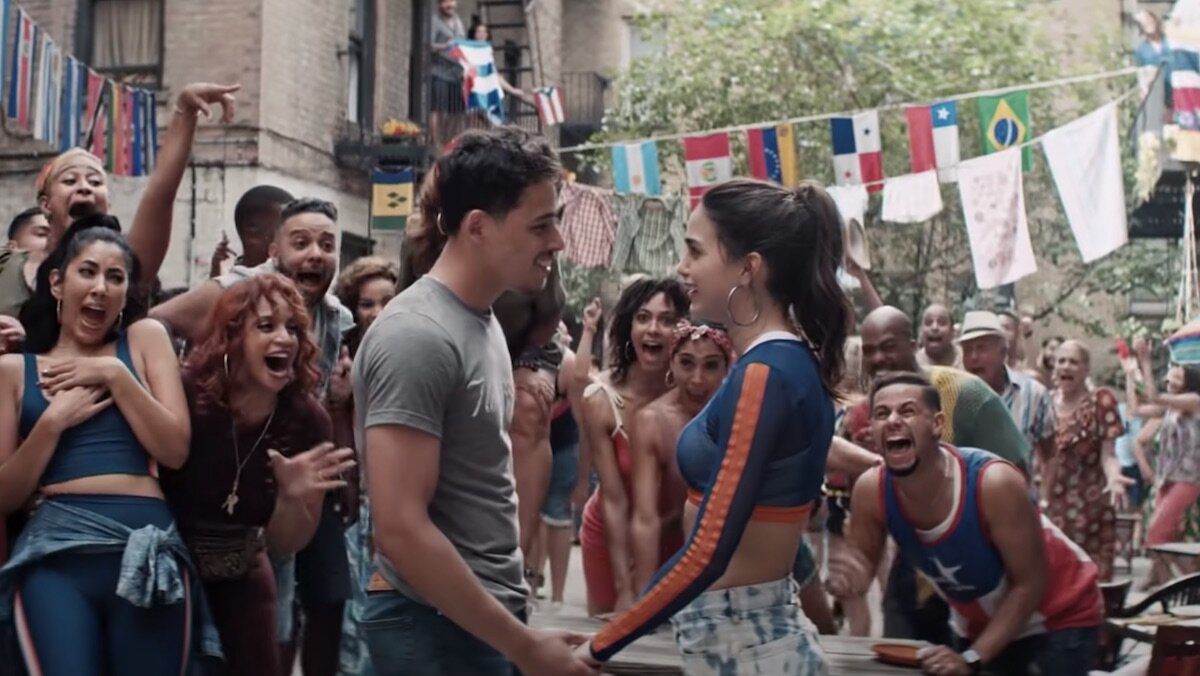IN THE HEIGHTS
Directing: B+
Acting: B+
Writing: B+
Cinematography: A-
Editing: B+
Music: A-
It’s been a long while since we got a mainstream movie musical release that was so much fun. It’s arguably unfair to hold it to the standard of live theater—I always say movies should be judged by their own merits, after all—but I still found myself regularly thinking about how much more exciting In the Heights almost certainly would been to see live on Broadway; I never did see a stage production of it. That said, adapting a play for the screen in a way that makes the movie even close to equally worthy in its own right is notoriously difficult, and I can certainly say this much: In the Heights the movie stands on its own.
Is it an instant classic? Will it endure in audience before for decades to come, in the same vein as The Sound of Music or the original West Side Story? Not even close. It’s easy to see this movie being part of the 2021 Oscar conversation, which takes us into next year, but will people still be talking much about In the Heights even two years from now? I’d be very surprised. But, does a movie have to be an instant classic to be a hell of a great time? Certainly not. This is a movie that’s having a moment, and its time is now. I absolutely encourage everyone to revel in it.
And there is much to love about it. When it comes to the filming of song and dance numbers, cinematography and editing are key; far too often choreography gets shot and cut together in a way that makes it impossible to see the achievement in choreography. It’s exactly the same principle with action movies: if you can’t get a clear picture of the movement, then what’s the point? In In the Heights, although the editing even here is occasionally too rapid-fire for my taste, there are just enough wide shots to truly wow you with the intricacy of synchronized and intricately laid out choreography. Many of these shots are in the New York neighborhood streets of the title. One memorably electric sequence takes place at a public pool, the camera moving in and around crowded swimmers, at one point even going under the water, culminating in a richly charismatic rap by supporting actor Gregory Diaz IV, leading a group of waders in synchronized slaps of the water. The kind of planning and execution that goes into this is deeply impressive.
I do have to wonder how much of what we see onscreen in this movie is augmented by special effects. In another memorable shot, our lead character, Usnavi (a spectacularly well cast Anthony Ramos) is seen rapping through the window of his corner store, the crowd on the street dancing in the reflection. This is clearly an effects shot—otherwise you’d see cameras and crew in the reflection of the window—but it is a memorable and effective one.
In the Heights is based on the Tony-winning musical stage play by Lin-Manuel Miranda (who pops up a few times here as a fringe character, selling snow cones), originally produced some eight years prior to Hamilton. Here it is adapted by Quiara Alegría Hudes, the first feature film she has written, and directed by Jon M. Chu (Crazy Rich Asians). It examines love of community as well as heritage, here being the mostly Latino population of Washington Heights in Manhattan, and a pretty diverse array of ethnic backgrounds within South and Central America, and largely the Caribbean. It looks at gentrification and residents of a beloved neighborhood getting priced out, which means there is a fairly sad undercurrent to all the joyful celebrations seen onscreen.
The one non-Latino principal character is Benny, played by Corey Hawkins, previously seen as Dr. Dre in Straight Outta Compton and a bunch of other films that arguably make him the most recognizable actor in In the Heights. Well, except, for some, maybe Jimmy Smits, who plays frustrated father to Nina (Leslie Grace), who is quitting college at Stanford due to the isolation from her community. She also happens to be Benny’s love interest, their romance being the B plot which oddly never gets any definitive resolution by the end of the film.
For Usnavi’s part, he has eyes for aspiring fashion designer Vanessa (Melissa Barrera), who faces her own uphill battle facing stereotypes as she works on her ambitions. Between these two romances, familial tensions between Nina and her father, and “Abuela Claudia” (Olga Merediz) playing matriarch to the community as businesses get priced out of the neighborhood, there’s a whole lot going on in this movie. It’s a wonder they managed to cut it down to 143 minutes. The music is always great, but the level of narrative urgency varies a bit, what with all the layers of story that need to be conveyed. The public pool sequence is the best, but there are others in the film that might also qualify as showstoppers, and collectively make this movie worth seeing—particularly in a theater.
And, not to worry: the story here is one, ultimately, of triumph, of characters successfully adapting to a changing environment. A lot is made of how the neighborhood Usnavi knows and loves is “disappearing,” and if you think about it deeply enough, there won’t be anything he can do about that in the end. But for now at least, he and his family and friends and neighbors—and you—can feel pretty great about the world and their place in it, humming associated melodies all the way home.
If you must join a crowd, you could do worse than this one.
Overall: B+

